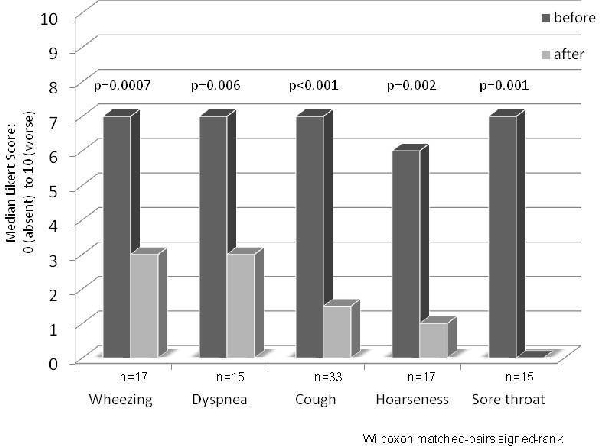Improvement of Respiratory Symptoms Following Heller Myotomy for Achalasia
Saurabh Khandelwal*1, Rebecca Petersen1, Roger P. Tatum2,1, Daniel M. Aaronson1, Fernando Mier1, Huseyin Sinan1, Ana V. Martin1, Carlos a. Pellegrini1, Brant K. Oelschlager1
1Surgery, University of Washington, Seattle, WA; 2Surgery, VA Puget Sound Health Care System, Seattle, WA
INTRODUCTION: Some patients with achalasia complain of respiratory symptoms. In this study we sought to define the prevalence, the pathogenesis and the effect of Heller myotomy on these symptoms. METHODS: We studied the course of 111 patients with achalasia who underwent Heller myotomy between 1994 and 2008 and who agreed to participate in this study. All patients completed a questionnaire postoperatively assessing the preoperative and postoperative prevalence and severity of symptoms using visual analog scales. Patients reporting respiratory symptoms (dyspnea, hoarseness, cough, wheezing, or sore throat) occurring at least once per week prior to myotomy, and/or history of asthma or pneumonia, were included for analysis. RESULTS: All patients presented with dysphagia as their primary complaint, and 63 (57%) reported respiratory disease or symptoms prior to surgery. They all underwent Heller myotomy and 51/63 (81%) had, in addition, an antireflux procedure (Dor or Toupet fundoplication). After a median follow-up of 71 months (range: 9-186 months), 55 (87%) patients experienced durable improvement in their dysphagia. The frequency and severity (Figure) of all respiratory symptoms decreased significantly. Twenty-four of the 29 patients (82%) who reported a history of pneumonia prior to surgery did not experience recurrent episodes after Heller myotomy. CONCLUSIONS: This study shows that achalasia is associated with a relatively high prevalence of respiratory symptoms and disease. As esophageal emptying improves, evidenced by resolution of dysphagia, respiratory problems disappear as well suggesting that they were caused by aspiration of retained food and secretions. The substantial improvement of respiratory symptoms and disease after Heller myotomy, which was heretofore not appreciated, is yet another benefit of surgical therapy for this disease.
Back to Program



